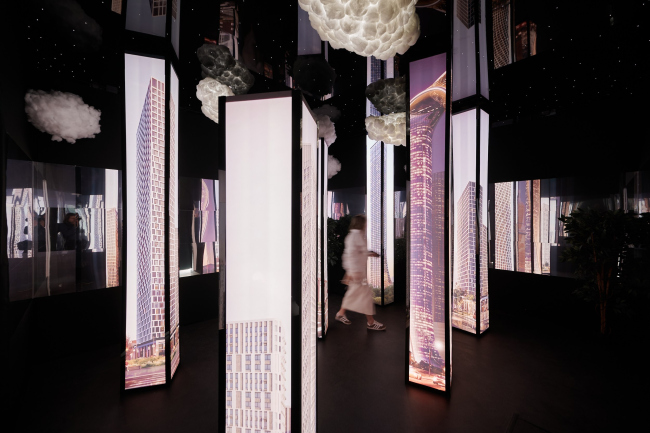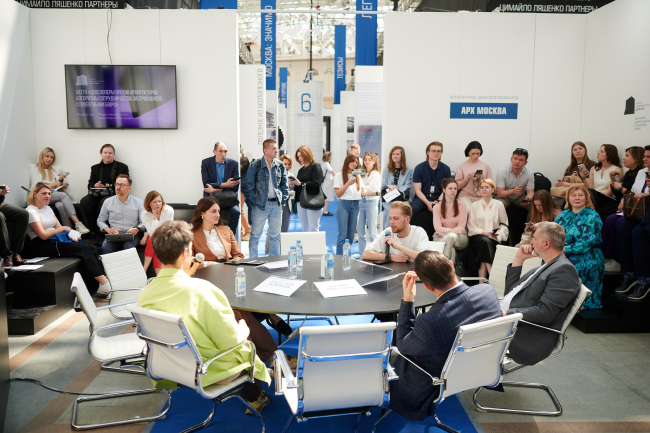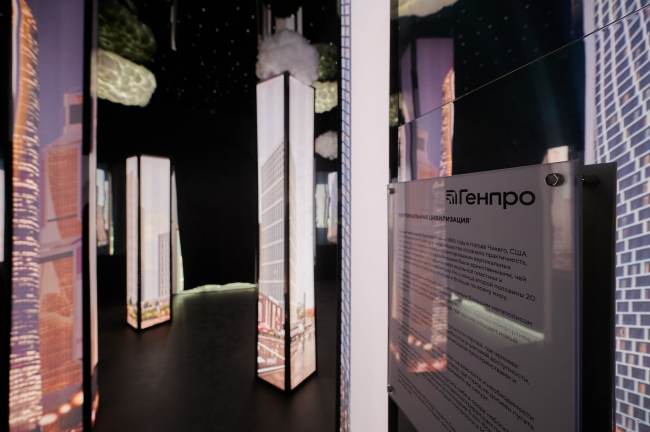|
Published on Archi.ru (https://archi.ru) |
|
| 10.06.2024 | |
|
Vertical Civilization |
|
|
Natalia Koriakovskaia |
|
| Studio: | |
|
Genpro considered the development of the vertical city concept and made it the theme of their pavilion at the “ArchMoscow” exhibition. No architectural forum bypasses the topic of skyscraper construction, and ArchMoscow was no exception. One of the ambassadors of this theme at the recent exhibition was the company Genpro, which dedicated their pavilion, titled “Vertical Civilization”, to high-rises. Inside, it looked pretty suprematist: glowing “architectons” of lightboxes with fragments of high-rises printed on them in a black space that evoked the image of outer space. Under the ceiling, there were curly clouds, clearly hinting at the ever-growing height of the urban skyline. The Genpro booth at ArchMoscow 2024Copyright: image courtesy by GenproGenpro showcased five of their high-rise projects in the pavilion – Sydney City, a residential complex on Shosseynaya Street, JOIS, N’ICE LOFT, and a project in Moscow-City. Inside the black room, the usual sense of tectonics is lost: it seems that the lightboxes float above the surface and, reflecting off the ceiling, vanish into infinity. This suprematist picture evokes memories of projects for flying cities. However, Genpro wants to convey that all this is no longer a utopia, but today’s reality. The five showcased high-rise projects are the Moscow skyline of the near future. Thus, moving from our reflection outside the pavilion, we enter the “city of skyscrapers” that emerged from a master plan drawn by Genpro. “The idea of the project is to show the process of the “growth” of the urban skyline as a kind of natural, aesthetically pleasing development” explains the pavilion’s curator, Genpro’s creative director, Evgeny Zelenov “This verticality does not oppress us, although many, of course, disagree with it and try to avoid it. But we need to adapt to the high-rise environment, as it is the future of Moscow”. Evgeny Zelenov, art director of GenproCopyright: image courtesy by GenproMake no mistake: skyscrapers are not a consequence of someone’s aesthetic taste or preferences, but a derivative of the market, economy, and the very structure of the modern city. Their construction is usually a necessity, even in spite of the fact that building structures over 150 meters tall is very expensive. I say “usually” because there are also examples of skyscrapers being endowed with a more symbolic function: hence the spires that increase the height of record-breaking buildings. However, the main bulk of high-rises emerges due to the high cost of land and the need for a high concentration of people, whose synergistic effect exceeds the costs and brings more economic benefits to the city. The history of skyscraper construction spans more than a hundred years, during which skyscrapers have managed to earn fame as the main feature of the utopian city, as well as the disdain of supporters of the conservation of the historical environment. Nevertheless, this is our present, Genpro reminds us once again. Moreover, if some time ago any building over 150 meters was considered a dominant structure and had a landmark status simply due to its size, now we are already talking about secondary skyscraper development. As Evgeny Zelenov says, essentially, an ensemble of environmental, background architecture and dominants is being created, similar to Paris in the Haussmannian times, only with taller buildings. But the principle is the same. 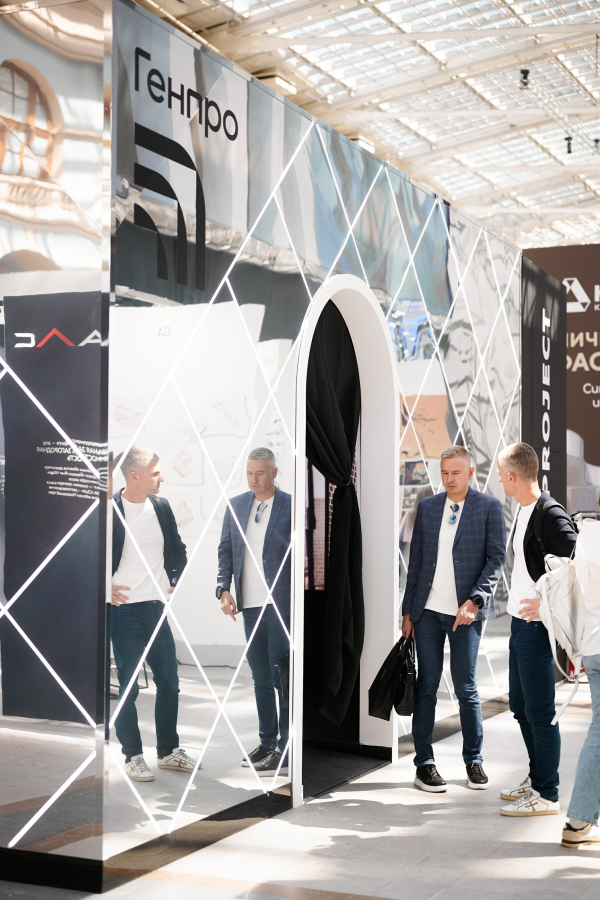 The Genpro booth at ArchMoscow 2024Copyright: image courtesy by Genpro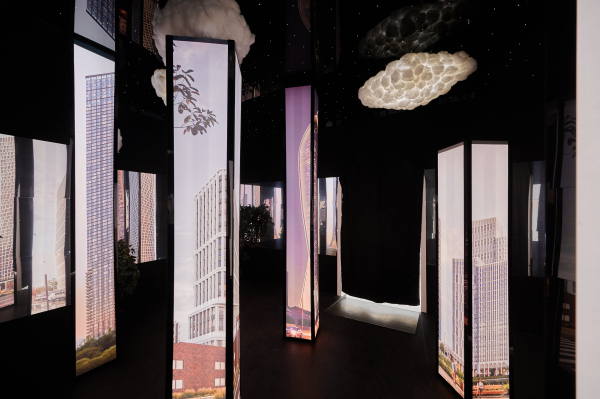 The Genpro booth at ArchMoscow 2024Copyright: image courtesy by Genpro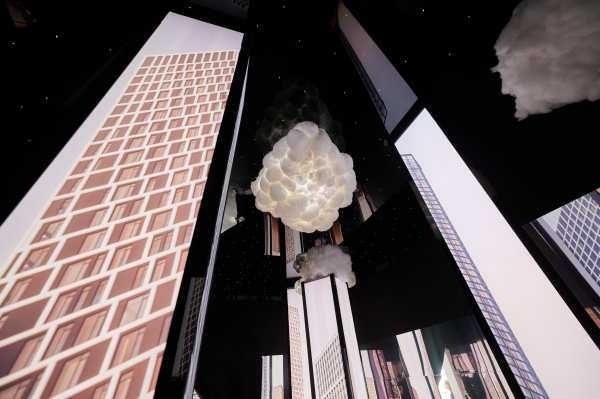 The Genpro booth at ArchMoscow 2024Copyright: image courtesy by GenproParticipants in the case session conducted by Genpro noted how the structure of buyer demand has been changing lately. According to surveys by product specialists, people have become bolder in buying apartments above the 20th floor. Experts believe that the mentality is changing, and city dwellers are no longer afraid to live higher than the generations before them did. Moreover, people even want to live higher up, where the air is cleaner. They also want to live in locations they could not afford in the format of medium- or low-rise housing of equivalent quality. As a result, what seemed impossible ten years ago is becoming the norm, driven by internal social and economic processes – overpopulation, rising housing costs, deteriorating environmental conditions, and changes in the labor market structure. Thus, the discussion around skyscraper construction is shifting to a different plane: high-rises are no longer debated from the perspective of whether they are needed or not, good or bad, but rather what benefits this phenomenon can bring to the city. Participants in the case session noted that the concept of a vertical city helps preserve biodiversity because skyscrapers necessarily include green areas and parks both outside and inside, for example, in the format of rooftop gardens, green walls, or terraces. In addition, such expensive projects are created with energy efficiency and environmental safety requirements in mind and make a significant contribution to reducing the carbon footprint. High-density development is also quite efficient from the perspective of the urban transportation framework since high-rise clusters are formed near transportation hubs. Case Session: “Vertical City. Modern reality of megalopolis development"Copyright: image courtesy by GenproFinally, according to market experts, the issue of emotional well-being depends more on the quality of the designed environment rather than the number of floors per se. The growing demand for apartments on higher floors confirms that for many, the panoramic view and other benefits of high-rise living outweigh the cons. What is a vertical city today? Any skyscraper project, such as JOIS or Sydney City, is like a layered cake: numerous service functions are brought inside, so that residents only need to move up and down within the complex for a complete living experience. Household services, shopping, restaurants, kindergartens, co-working spaces, and offices – all of these, especially popular due to the rise of remote work – are concentrated in one location, allowing residents to save time on commuting. The Genpro booth at ArchMoscow 2024Copyright: image courtesy by GenproFor the modern megalopolis, high-density development is perhaps the only way not only to regulate traffic loads but also to preserve green or historical areas and save space by distributing people over a smaller area. The “Vertical Civilization” project, presented by Genpro at ArchMoscow, essentially marks the end of the debate between urbanists and anti-urbanists: it captures the vision of the future Moscow that is actively forming right before our eyes and is unlikely to backtrack. “The verticality of the city is inevitable, and we are crossing this barrier right now. Needs that did not exist thirty years ago are coming to the forefront, and people prefer locations and the infrastructure set that the “vertical city” provides over mid-rise developments far from the center. A new skyline is gradually emerging, a new silhouette that used to exist only on paper. Urbanization dictates economic parameters, and those who choose to live in places with a concentration of various resources and social benefits are also choosing density” Evgeny Zelenov says. The Genpro booth at ArchMoscow 2024Copyright: image courtesy by GenproThe increase in the number of floors is, of course, not the final point in the development of the modern city. When asked what to expect next, Evgeny replies that infrastructure will grow upwards along with the buildings. “Remember how Le Corbusier planned to run transportation over the roofs of residential buildings, creating multi-tiered urban mega-structures. Well, I think we are heading towards this multi-layered city now. We are already living in an era of developing unmanned transport, and I believe that the chain of transport infrastructure on the ground will be completed, and we will move to transport above ground – with the help of cars, drones, and even people themselves. Then vertical development will be more integral, with your orders or even you yourself being delivered directly to your apartment. I would like to see that, and I think we will witness the beginning of this era”. |
|
